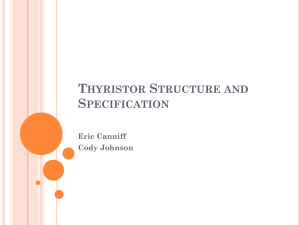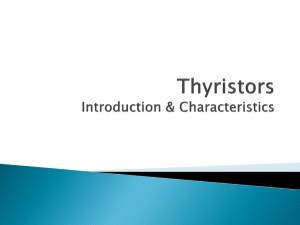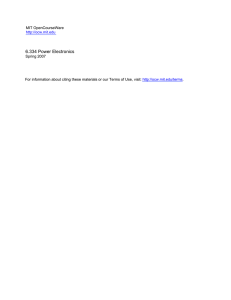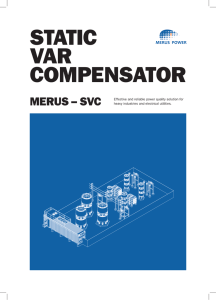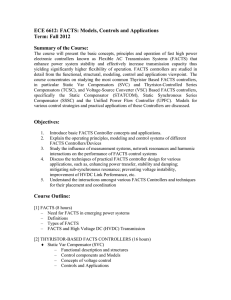Proposed Terms And Definitions For Flexible Ac Transmission System
advertisement
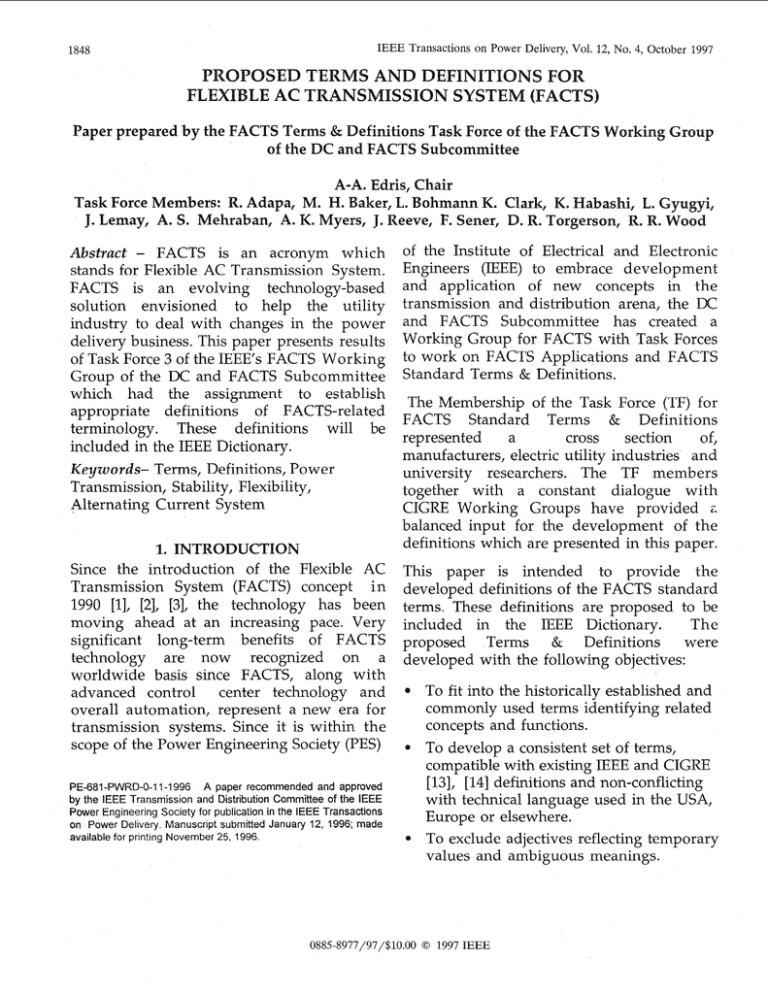
IEEE Transactions on Power Delivery, Vol. 12, No. 4,October 1997 1848 Paper prepared by the FACTS Terms & Definitions Task Force of the DC and FACTS Subcommittee A-A. Edris, Chair Task Force Members: Adapa, M. H. Baker, L. Bohmann K. Clark, K. J. Lemay, A. S . Mehraban, A. K. yers, J. Reeve, F. Sener, . Abstract - FACTS is an acronym which stands for Flexible AC Transmission System. FACTS is an evolving technology-based solution envisioned to help the utility industry to deal with changes in the power delivery business. This paper presents results of Task Force 3 of the IEEE’s FACTS Working Group of the DC and FACTS Subcommittee which had the assignment to establish appropriate definitions of FACTS-related terminology. These definitions will be included in the IEEE Dictionary. Keywords- Terms, Definitions, Power Transmission, Stability, Flexibility, Alternating Current System of the Institute of Electrical and Electronic Engineers (IEEE) to embrace development and application of new concepts in the transmission and distribution arena, the and FACTS Subcommittee has created a Working Group for FACTS with Task Forces to work on FACTS Applications and FACTS Standard Terms & Definitions. The Membership of the Task Force (TF) for FACTS Standard Terms & Definitions represented a cross section of, manufacturers, electric utility industries and university researchers. The TF members together with a constant dialogue with CIGRE Working Groups have provided z balanced input for the development of the definitions which are presented in this paper. Since the introduction of the Flexible AC This paper is intended to provide the Transmission System (FACTS) concept i n developed definitions of the FACTS standard 1990 [l], [2], [3], the technology has been terms. These definitions are proposed to be moving ahead at an increasing pace. Very included in the EE Dictionary. The significant long-term benefits of FACTS proposed Terms & Definitions were technology are now recognized on a developed with the following objectives: worldwide basis since FACTS, along with advanced control center technology and 0 To fit into the historically established and commonly used terms identifying related overall automation, represent a new era for concepts and functions. transmission systems. Since it is within the scope of the Power Engineering Society (PES) 0 To develop a consistent set of terms, compatible with existing IEEE and CIG [13], [14] definitions and non-conflicting PE-681-PWRD-0-11-1996 A paper recommended and approved by the IEEE Transmission and Distribution Committee of the IEEE with technical language used in the USA, Power Engineering Society for publication in the IEEE Transactions Europe or elsewhere. on Power Delivery. Manuscript submitted January 12, 1996; made available for printing November 25, 1996. 0 To exclude adjectives reflecting temporary values and ambiguous meanings. 0885-8977/97/$10.00 0 1997 IEEE 1849 2. FACTS TERMS AND DEFINITIONS The definitions presented in the following are divided into basic definitions and definitions of Controllers that serve specific function(s). The given categorization is the result of extensive discussions and compromises. 2.1 Basic Definitions Flexibility of Electric Power Transmission The ability to accommodate changes in the electric transmission system or operating conditions while maintaining sufficient steady state and transient margins. Flexible AC Transmission System (FACTS) Alternating current transmission systems incorporating power electronic-based and other static controllers to enhance controllability and increase power transfer capability. FACTS Controller A power electronic-based system and other static equipment that provide control of one or more AC transmission system parameters. 2.2 FACTS Controllers Definitions The definitions presented in the following are organized according to their respective connection to the controlled ac transmission system. 2.2.1 Shunt Connected Controllers Battery Energy Storage System (BESS) A chemical-based energy storage system using shunt connected, voltage sourced converters capable of rapidly adjusting the amount of energy which is supplied to or absorbed from an ac system. Static Synchronous Compensator (SSC or STATCOM) A static synchronous generator operated as a shunt-connected static v ar compensator whose capacitive or inductive output current can be controlled independent of the ac system voltage. Static Condenser (STATCON) This term is deprecated in favor of the Static Synchronous Compensator (SSC or STATCOM). Static Synchronous Generator (SSG) A static, self-commutated switching power converter supplied from an appropriate electric energy source and operated to produce a set of adjustable multi-phase output voltages, which may be coupled to an ac power system for the purpose of exchanging independently controllable real and reactive power. 0 Static Var Compensator (SVC) A shunt-connected static var generator or absorber whose output is adjusted to exchange capacitive or inductive current so as to maintain or control specific parameters of the electrical power system (typically bus voltage). Static Var Generator or Absorber (SVG) A static electrical device, equipment, or system that is capable of drawing controlled capacitive and/or inductive current from an electrical power system and thereby generating or absorbing reactive power. Generally considered to consist of shuntconnected, thyristor-controlled reactor(s) and/or thyristor-switched capacitors. Static Var System (SVS) A combination of different static and mechanically-switched var compensators whose outputs are coordinated. Superconducting Magnetic Energy Storage (SMES) A Superconducting electromagnetic energy storage device containing electronic 0 1850 converters that rapidly injects and/or absorbs include transiently rated energy storage or real and/or reactive power or dynamically energy absorbing devices to enhance the dynamic behavior of the power system by controls power flow in an ac system. additional temporary real power Thyristor Controlled Braking Resistor compensation, to increase or decrease (TCBR) momentarily, the overall real (resistive) A shunt-connected, thyristor-switched voltage drop across the line. resistor, which is controlled to aid stabilization of a power system or to 0 Thyristor controlled Series Capacitor minimize power acceleration of a generating (TCSC) unit during a disturbance. A capacitive reactance compensator which consists of a series capacitor bank shunted by thyristor controlled reactor in order to Thyristor Controlled Reactor (TCR) A shunt-connected, thyristor-controlled provide a smoothly variable series capacitive inductor whose effective reactance is varied reactance. in a continuous manner by partialThyristor Controlled Series conduction control of the thyristor valve. Compensation An impedance compensator which is applied Thyristor Switched Capacitor (TSC) A shunt-connected, thyristor-switched in series on an ac transmission system to capacitor whose effective reactance is varied provide smooth control of series reactance. in a stepwise manner by full- or zeroconduction operation of the thyristor valve. Thyristor Switched Reactor (TSR) A shunt-connected, thyristor-switched inductor whose effective reactance is varied in a stepwise manner by full- or zeroconduction operation of the thyristor valve. Var Compensating System (VCS) A combination of different static and rotating var compensators whose outputs are coordinated. 0 2.2.2 Series Connected Controllers Static Synchronous Series Compensator (SSSC or S ~ C ) A static, synchronous generator operated without an external electric energy source as a series compensator whose output voltage is in quadrature with, and controllable independently of, the line current for the purpose of increasing or decreasing the overall reactive voltage drop across the line and thereby controlling the transmitted electric power . The S3C may Thyristor Controlled Series Reactor (TCSR) An inductive reactance compensator which consists of a series reactor shunted by a thyristor controlled reactor in order to provide a smoothly variable series inductive reactance. Thyristor Switched Series Capacit (TSSC) A capacitive reactance compensator which consists of a series capacitor bank shunted by a thyristor switched reactor to provide a stepwise control of series capacitive reactance. Thyristor Switched Series Com An impedance compensator which is applied in series on an ac transmission system to provide a step-wise control of series reactance. 0 Thyristor Switched Series Reactor (TS An inductive reactance compensator which consists of series reactor shunted by thyristor 1851 switched reactor in order to provide a step- 2.2.4 Other Controllers Thyristor Controlled Voltage Limiter wise control of series inductive reactance. (TCVL) A thyristor-switched metal-oxide varistor 2.2.3 Combined Shunt and Series (MOV) used to limit the voltage across its Connected Controllers terminals during transient conditions. Interphase Power Controller (IPC) A series-connected controller of active and reactive power consisting ,in each phase ,of 3. PRESENT APE’LICATION STATUS OF inductive and capacitive branches subjected FACTS CONTROLLERS to separately phase-shifted voltages. The active and reactive power can be set FACTS Controllers are currently in various independently by adjusting the phase shifts stages of maturity. Some, such as SVCs, and/or the branch impedances, using STATCOM and TCSCs, are commercially Others are either in the mechanical or electronic switches. In the available. particular case where the inductive and development or demonstration stages. capacitive impedances form a conjugate pair, 3.1 Commercially Available each terminal of the IPC is a passive current FACTS Controllers source dependent on the voltage at the other The FACTS Controllers for which terminal. commercial or demonstration projects exist Thyristor Controlled Phase Shifting include: Transformer (TCPST) Static Var Compensator (SVC) A phase-shifting transformer, adjusted by thyristor switches to provide a rapidly SVCs have been in use since the early 1960s. variable phase angle. The SVC application for transmission voltage control began in the late 1970s. Since Unified Power Flow Controller (UPFC) that time, many SVCs have been applied A combination of a static synchronous worldwide for voltage control and, in some compensator (STATCOM) and a static cases for stability enhancement. synchronous series compensator (S3C) which Thyristor SwitchedKontrolled Series are coupled via a common dc link, to allow Capacitor (TSSCECSC) bi-directional flow of real power between the series output terminals of the S3C and the Since 1991 there have been three shunt output terminals of the STATCOM, installations, in the United States of America and are controlled to provide concurrent real (USA), using thyristor switches to obtain a and reactive series line compensation controllable series capacitive compensation. without an external electric energy source. The UPFC, by means of angularly The first installation [4] was essentially unconstrained series voltage injection, is experimental in nature, testing the hardware able to control, concurrently or selectively, of thyristor switched series capacitor (TSSC). the transmission line voltage, impedance, A thyristor valve was applied across one and angle or, alternatively, the real and phase of a capacitor module on a series reactive power flow in the line. The UPFC capacitive compensated 345 kV transmission may also provide independently controllable line Kanawa River - Matt Funk line at Kanawa River Substation in West Virginia. shunt reactive compensation. The second installation [5] was a thyristor controlled series capacitor (TCSC). It consists 1852 of a fixed capacitor shunted by a thyristor provide phase shifting and/or series controlled reactor, providing continuously compensation. Both the STATCOM and controlled series capacitive compensation. It series subsystem will consist of a 160 MVA was installed in a 300 km, 230 kV voltage sourced, multi-pulse, harmonic transmission line at the Kayenta Substation neutralized GTO inverter and magnetic in Arizona. The functions of this installation interface. The UPFC will be installed on 138 are to increase power transfers to the line’s kV transmission line at Inez substation i n thermal limit and evaluate the TCSC ability Kentucky. The installation is planned to be to control power flow, line impedance, completed by the end of 1997. damp electromechanical power oscillations, and mitigate Subsynchronous Resonance 3.3 Future FACTS Contro (SSR). FACTS Controllers which are expected to be available in the foreseeable future include: The third installation, at the Slatt substation in Oregon, is also a TCSC [6]. The Slatt TCSC 0 Thyristor Controlled Phase Shifting Transformers (TCPST) [lo] is comprised of six identical thyristorcontrolled capacitor modules connected i n 0 Static Synchronous Series Compensator series. (SSSC or ~3 C) ~111 e Interphase Power Controller (IPC) [12] 0 Static Synchronous Com 4. CONCLUSIONS This paper presents proposed Terms & Definitions of FACTS. The proposed definitions were developed with the following objectives: To fit into the historically established and commonly used terms identifying related In operation the 100 Mvar STATCOM will concepts and functions. provide voltage control to the 161 kV bus voltage during daily buildup to minimize 0 To develop a consistent set of terms, compatible with existing IEEE and CIGRE the activation of the on load tap changer of definitions and non-conflicting with the 500 kV / 161 kV transformer. Furthermore, the STATCOM will provide technical language used in the USA, adequate voltage support to the 161 kV and Europe or elsewhere. 500 kV buses during light and peak load 0 To exclude adjectives reflecting temporary conditions. values and ambiguous meanings. These definitions will be included in the 3.2 FACTS Controllers Currently Under IEEE Dictionary. Development 0 Unified Power Flow Controller (UPFC) [8] The paper has also presented the present status of FACTS Controllers, commercially The first large-scale UPFC will consist of a available, currently under development, and shunt voltage sourced inverter (STATCOM) those to be developed in the future. rated at 2 160 MVA to provide 2 150 Mvar 5. CES reactive power support and 50 MW real power through the DC link required in full 1. N. G. Hingorani, “High Power Electronics UPFC mode of operation. The series voltage and Flexible AC Transmission System”, Joint sourced inverter is rated 160 MVA to The most recent STATCOM installation is a + 100 Mvar STATCOM [7l which is installed in November 1995 at Sullivan (500 kV / 161 kV) substation in Johnson City, Tennessee. In 1991 an 80 Mvar was installed at the Inuyama Switching Station in Japan [9]. 1853 APC/IEEE Luncheon Speech, April 1988 at the American Power Conference 50th Annual Meeting in Chicago, Printed I€€€ Power Engineering, July 1988. 2. N. G. Hingorani, "Power Electronics i n Electric Utilities: Role of Power Electronics i n Future Power Systems", Invited Paper, Proceedings of the IEEE Special Issue, Vol. 76, No. 4, April 1988. 3. L. Gyugyi, "Dynamic Compensation of AC Transmission Lines by solid-state Synchronous Voltage Sources," IEEE Transactions on Power Delivery, Vol. 9, No. 2, pp. 904-911, April 1994. 4. A.J. F. Kari, R.A. Byron, B. J. War, A.S. Mehhraban, M, Chamia, P. Halvarsson, L. Angquist, "Improving Transmission System Performance Using Controlled Series Capacitors, CIGRE Paper 14/37/3&07, Paris, France, 1992. 5. N. Christl, R. Hedin, P.E. Kraucs, P. Luetzelberger, S.M. McKenna, A.H. Montoya, K. Sadek, D. R. Torgerson, "Advanced Series Compensation (ASC) with Thyristor Controlled Impedance," CIGRE Paper 14/37/38-07, Paris, France, 1992. 6. J. Urbanek, R.J. Piwko, E.V. Larsen, B.L. Damsky, B.C. Furumasu, W. Mittlelstadt, J.D. Eden, Thyristor Controlled Series Compensation- Prototype Installation at Slatt 500 kV Substation," I€€€ Transactions o n Power Delivery, pp. 1460-1469, July 1993. 7. C.D. Schauder, M. Gernhardt, E. Stacy, T.W. Cease, A. Edris, "Development of 100 Mvar Static Condenser for Voltage Control of Transmission Systems," I€€€ Transact ions on Power Delivery, Vol. 10, No. 3, pp. 14681496, July 1995. 8. L. Gyugyi, C.D. Schauder, S.L. Williams, T.R. Reitman, D.R. Torgerson, A. Edris, "The Unified Power Flow Controller: A New Approach to Power Transmission Control," I€€E Transactions on Power delivery, Vol. 10, No .2, pp. 1085-1097, April 1995 9. S. Mori, K. Matsuno, M. Takeda, and M. Seto," Development of Large Static Var Generator Using Self-Commutated Inverters for Improving Power System Stability," Paper NO. 92 WM 165-1 PWRS, I€€E/PES 2992 Winter Meeting, New York, New York, January 26-30,1992. 10. S. Nyatti, M.E. Eitzmann, J. Kappenman, D. Van House, N. Mohan, A. Edris, Design Issues for a Single-Core Transformer Thyristor Controlled Phase Angle Regulator," I€€€ Transactions on Power Delivery, Vol. 10, No. 4, pp. 2013-2019, October 1995. 11. L. Gyugyi, C.D. Schauder, K. K. Sen," Static Synchronous Series Compensator: A Solid-state Approach to the Series Compensation of Transmission Lines," Paper to be presented at IEEE/PES Winter Power Meeting, Baltimore, MD, January '8996 12. J. Brochu, P. Pelletier, Beauregard, G. Morin, "Interphase Power Controller Adapted to the Operating Conditions of Networks ,I1 I€€€ Transactions on Power Delivery, Vol. 10, No. 2, pp. 961-969, April 1995. 13. Static Var Compensators, CIGRE Working Group 38-01, Task Force No. 2 on SVC, Cigre, Paris, 1986, Edited by I. A. Erinmez 14. "FACTS Overview", published by CIGRE and IEEE PES, 1995, Reference IEEE 95 TP 108.
